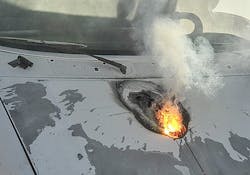High-energy laser with 30 kilowatts of power shown to kill light truck in seconds from a mile away
BETHESDA, Md., 10 March 2015. 2015 High-energy laser experts at Lockheed Martin Corp. are moving laser weapons technology forward with a recent test that used a 30-kilowatt fiber laser to burn through the engine manifold of a small truck in a matter of seconds from more than a mile away.
The prototype laser weapon disabled the engine of a small truck during a recent field test, demonstrating the precision of laser weapons to protect military forces and critical infrastructure, Lockheed Martin officials say.
The prototype ground-based laser weapon is called the Advanced Test High Energy Asset (ATHENA). The truck used for the test was mounted on a test platform with its engine and drive train running.
The test represents the next step to providing lightweight and rugged laser weapon systems for military aircraft, helicopters, ships and trucks," says Keoki Jackson, chief technology officer of Lockheed Martin.
Related: Lockheed Martin Aculight to develop 60-kilowatt laser to kill UAVs, rockets, and mortars
Lockheed Martin is headquartered in Bethesda, Md., and several of the company's business segments are working on components of laser weapon systems. The Lockheed Martin Laser and Sensor Systems segment in Bothell, Wash. (formerly Lockheed Martin Aculight), is developing fiber lasers; Lockheed Martin Space Systems in Sunnyvale, Calif., is working on integrated defensive systems for aircraft, and Lockheed Martin Mission Systems and Training in Akron, Ohio, is developing lasers to defend aircraft from incoming missiles.
Lockheed Martin Laser and Sensor Systems is developing a 60-kilowatt fiber laser module for a truck-mounted laser weapon system intended to shoot down enemy unmanned aerial vehicles (UAVs), rockets, artillery rounds, and mortars as part of the U.S. Army High Energy Laser Mobile Demonstrator (HEL MD) project.
Previously, Lockheed Martin Laser and Sensor Systems developed electrically driven high-power laser technology for laser weapon systems as part of the Army Robust Electric Laser Initiative (RELI) program.
Lockheed Martin Space Systems is demonstrating prototype high-energy laser tail gun intended to protect combat aircraft from attacks from the rear as part of the Aero-Adaptive/Aero-Optic Beam Control (ABC) program of the U.S. Defense Advanced Research Projects Agency (DARPA) in Arlington, Va. The project seeks to give 360-degree coverage for high-energy laser weapons operating on military aircraft.
Lockheed Martin Mission Systems and Training is working on the DARPA Project Endurance to develop small, lightweight technology for pod-mounted laser weapons to protect manned aircraft and unmanned aerial vehicles (UAVs) from electro-optical and infrared (EO/IR)-guided surface-to-air missiles.
“Fiber-optic lasers are revolutionizing directed energy systems,” Jackson says. “We are investing in every component of the system -- from the optics and beam control to the laser itself -- to drive size, weight, and power efficiencies."
The truck-killing demonstration marked the first field testing of an integrated 30-kilowatt, single-mode fiber laser weapon system prototype, Lockheed Martin officials say.
Through a technique called spectral beam combining, several fiber laser modules form one powerful, high-quality beam that provides greater efficiency and lethality than multiple individual 10-kilowatt lasers used in other systems, company officials say.
Related: Northrop Grumman, Lockheed Martin to develop pod-mounted aircraft and UAV laser defenses
ATHENA is based on the 30-kilowatt Area Defense Anti-Munitions (ADAM) laser weapon system developed by Lockheed Martin Space Systems in Sunnyvale, Calif., which the company has demonstrated against small aircraft and boats. It incorporates the 30-kilowatt Accelerated Laser Demonstration Initiative (ALADIN) fiber laser developed by Lockheed Martin Integrated Defense Technologies in Bothell, Wash.
For more information contact Lockheed Martin Laser and Sensors Systems online at www.lockheedmartin.com/us/products/aculight, Lockheed Martin Space Systems at www.lockheedmartin.com/us/ssc, or Lockheed Martin Mission Systems and Training at www.lockheedmartin.com/us/mst.

